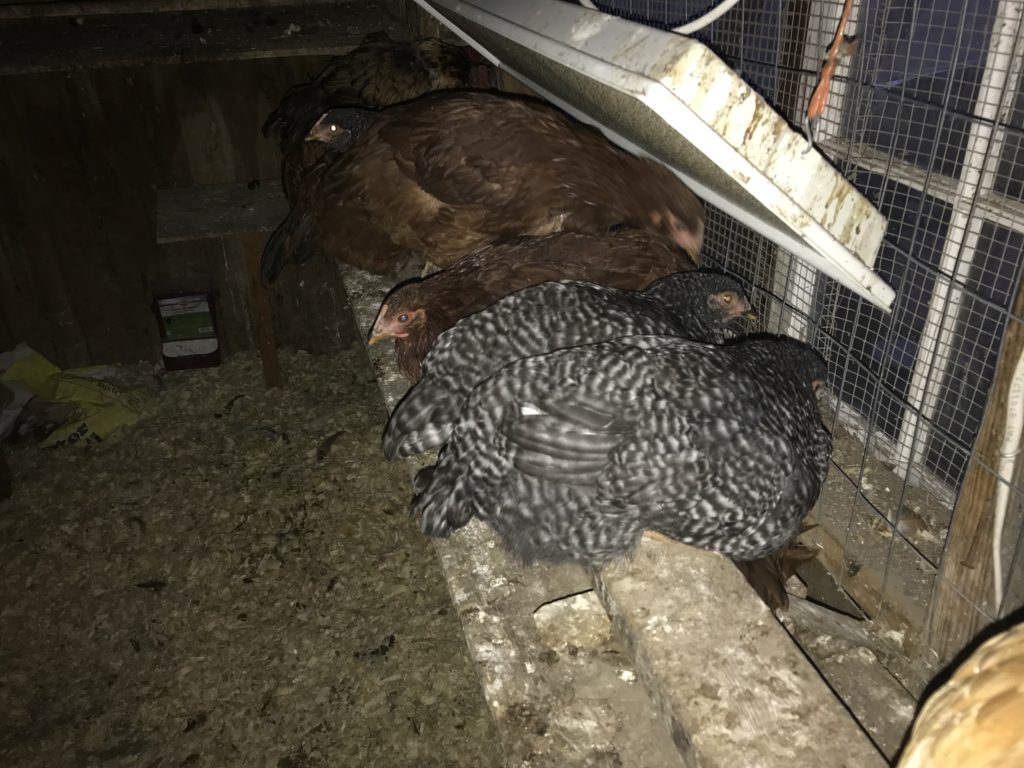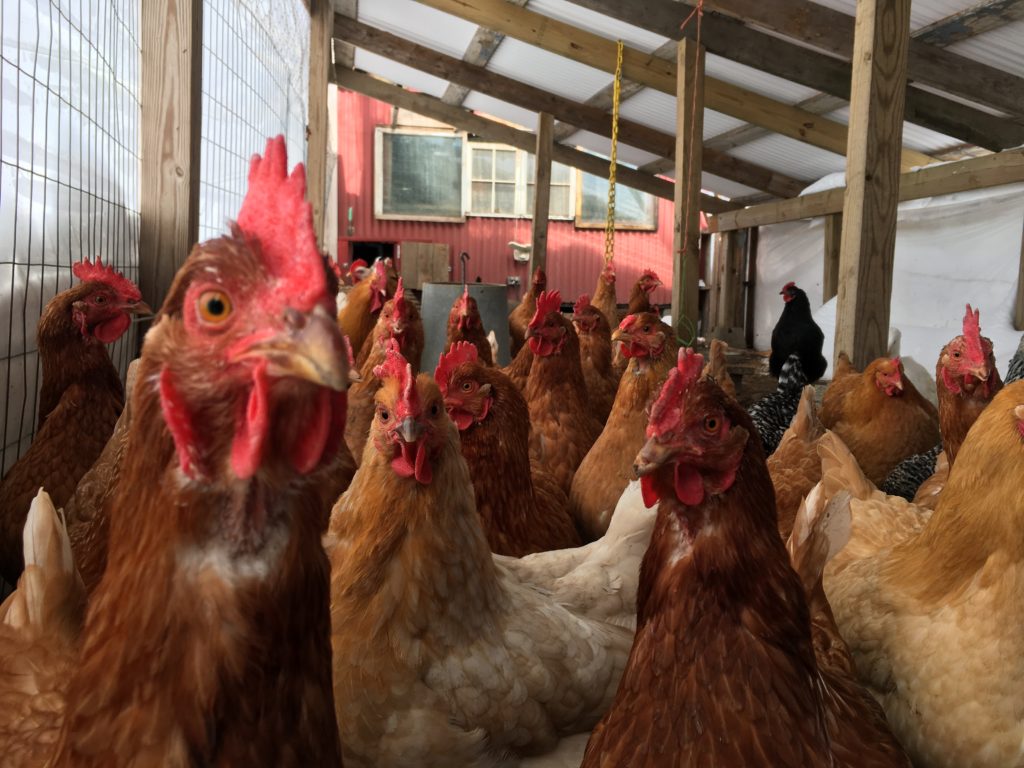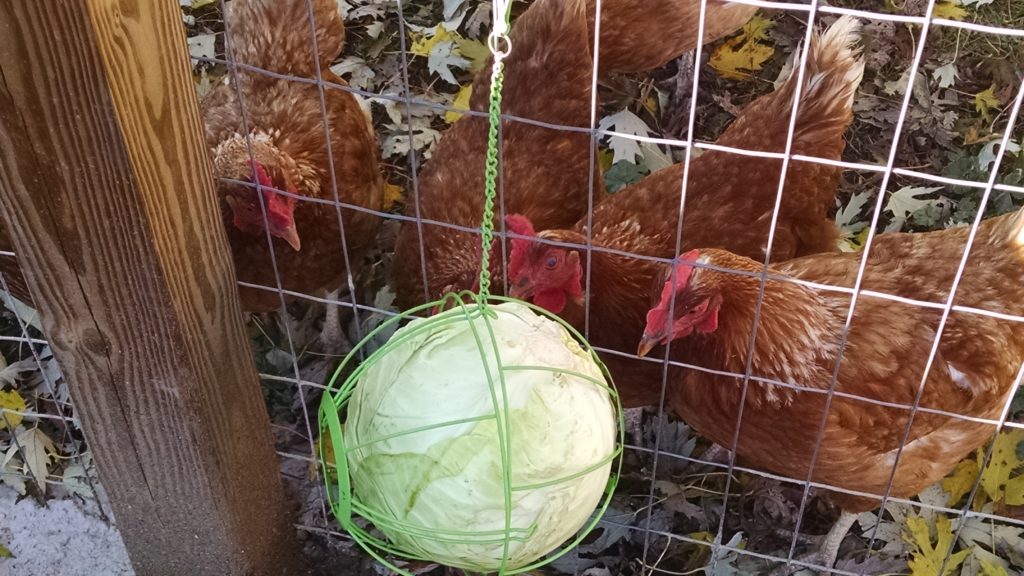Traci DeLore has great ideas for winterizing chicken homes and keeping cooped up birds entertained. (All photos by author.)
Winterizing the coop and run is an important item on your late-fall flock “to-do” list. Our feathery friends are, for the most part, well suited to handle most winter weather. However, there are a number of steps we can take to make sure chickens make it through the winter happy and healthy.

A roof over part of the run and heavy duty plastic help keep the winter weather out of my run.
Winterizing the Coop
First, let’s look at winterizing the coop. Most of us think about battening down the hatches for winter, closing windows and doors up tight to stop cold drafts. However, some ventilation is necessary in your chicken coop. Air flow should be allowed above the birds’ heads. So don’t want to leave a door propped open, which would blow a cold draft under the flock. The best solution I’ve found is louvered vents placed up high in the walls of the coop. Placed on opposite sides of the coop, vents allow for air flow. The louvers let you close the vents in the event of severe cold or windy weather.
Next, look for cracks and gaps and other places where air might blow through below the roosts. A can of expanding foam insulation is generally a quick fix to fill such gaps and block drafts.
To Heat or Not
I’m not a fan of heating the coop, and I don’t heat mine. A healthy bird should do just fine keeping warm in a draft-free coop. I do, however, hang a radiant heater above one section of the roost in my coop. This heater doesn’t heat the air; it only heats whatever is directly below it. Any of my flock who feel they need extra warmth (a late molter, perhaps?) can warm up as needed.

A radiant heater in my coop provides a space for hens that feel the need to warm up.
My coop features a large opening covered with welded wire to serve as a window. For the winter, I have some old wood-framed storm windows that I put over the outside and fasten to the coop for the winter. I leave a small gap at the top for some additional ventilation.
Don’t Forget the Floor
The final step in getting the coop ready is a thick layer of insulating bedding on the floor. Over the years, I’ve tried hay, straw, and pine shavings. The shavings work the best for me. Something else might work best for you. A lot of it depends on the size and setup of your coop and whether or not you have a mixed flock. As I also have ducks, shavings are the easiest option for me to keep the bedding clean.
As my ducks sleep on the coop floor, I don’t use the deep litter method. Some use this method, which is basically composting the bedding right in the coop by continually adding clean bedding to the top of the mix, to provide a natural heat source in their coop.
Winterizing the Run

Storm windows on the coop plus a roof over the run and plastic “walls” to keep out the snow make for a happy flock all winter long.
I live in Central New York. Winter arrives early and usually stays longer than welcome – at least for me. Keeping my flock of 61 chickens and three ducks locked up in a 10-foot by 12-foot coop all winter long just isn’t an option.
I have a fairly good sized run, and it’s taken us a few years to come up with a good method to winterize the run so the flock can still enjoy at least a portion of it all winter long. A slanted roof covers almost half the run. We cover the open sides with heavy duty clear plastic. My husband and I jokingly call it the chicken greenhouse, but it truly almost functions as one. The temperature inside the covered area, which is protected from the wind, can be almost 10 degrees warmer.
The setup gives the flock access to almost half of the run so they can still dust bathe and get a little exercise. It also provides space for feed and water dishes outside of the coop. Feed inside attracts rodents. Water inside the coop is a big no-no as moisture encourages frostbite.
Beating Winter Boredom

Activities and treats help beat the boredom in winter. A large treat block can keep the flock busy for days.
The final step in winterizing the coop and run is planning boredom busters for the flock. My flock free ranges part of the day until the weather makes it impossible. They get to roam around, exploring, looking for bugs, and doing whatever else they want. Being confined to an enclose space is boring! Therefore, I try to come up with a variety of things from treats to toys to keep the flock entertained during the winter months.

A hanging cabbage serves two purposes. It gives the chickens some healthy greens, and also keeps them busy as they peck at the swinging treat.
I have hanging baskets that will hold a head of cabbage or bunch of kale for the flock to snack on. A soda bottle with some small openings cut into it makes a great seed toy when hung from the rafters. The hens have to peck at the moving bottle to get some yummy seeds to fall out. On the coldest days, I hang suet blocks for the flock. When the weather permits, I will even use the snow blower to make a few paths around the yard for the flock to roam.

On warmer, sunny days, a path through the snow allows the flock to get out of the run and enjoy a new view.
The ultimate goal is to get the flock through the winter safe and happy and ready to start laying lots of eggs once that spring sunshine appears. Winterizing the coop and run is the first step toward that goal.
Traci DeLore grew up around chickens on her family’s farm, but didn’t start keeping her own chickens until she was in her 40s. Her desire to keep chickens came from a desire to have her own fresh eggs from chickens she knew were well cared for and happy. Traci started with six chickens – and then chicken math took over. These days, she has about 60 chickens — and three “rotten” ducks. (I say this because having ducks is like living with toddlers.) Traci also raises and processes her own meat chickens on occasion.













2 Comments
Thanks for the helpful tips! Much appreciated. I’d like to add one more.
I use the deep litter method and don’t clean out the coop all winter (28 chickens, small coop). The trick is to liberally sprinkle biochar over the litter every time you add a new layer of straw/hay/shredded paper. Biochar virtually eliminates odor by adsorbing the ammonia and nitrates, absorbing excess moisture and super-charging your litter for your garden in the spring. And the girls love it! They will eat quite a bit – which is great for their health: adds grit, absorbs toxins and neutralizes acids. However, If your chickens get free access to your biochar stash, they’ll eat an incredible amount, which isn’t going to hurt them but you want that stash to last all winter!
I make my own biochar – free and easy. If you’re buying it, make sure you purchase uncharged or plain biochar (i.e., no fertilizers or other additives). Augmented biochar is not necessary and in fact, counterproductive.
In my 8×10 coop, I use ~5-10 gallons of biochar each winter. That said, our chickens have a large covered dirt area as well as a couple of acres to free-range every day so the coop is not too small for that many. If you have to confine your girls all winter, the biochar will help but you will have to clean the coop out more frequently.
If you don’t know much about biochar, there’s a comprehensive article on my website – terraflora.us.
Great advice, and article thanks!